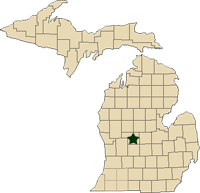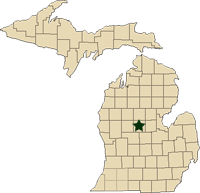Regional reports on Michigan field crops – June 16, 2011
MSU Extension educators’ pest and field crop updates for Michigan.
This week’s regional reports:
- Southeast Michigan – Ned Birkey
- Southwest Michigan – Bruce Mackellar
- West Central Michigan – Fred Springborn
- Central Michigan – Paul Gross
Southeast Michigan – Ned Birkey, Michigan State University Extension
|
Weather has been terrific with moderate temperatures and little to no rain. Overnight some rain fell, which will help with some crusted soils. Even though there is subsoil moisture, the topsoil has been dry and some rain is welcome. There are several fields with drowned out areas from previous rains so replanting will be filling in those areas.
Alfalfa first cutting is finishing up with very good yields and good to very good quality. There is sufficient soil moisture to get the second cutting off to a good start. Some hay fields are being plowed under and planted to silage and late season corn.
Corn re-planting is going on and finishing up this week. Advanced fields are at the V6 growth stage, however many fields were planted late and are spike to V4 stage. Sidedressing nitrogen and post-emerge weed control are going on. Some fields with nitrogen applied as early as March show nitrogen deficiency. European corn borer trap counts had very low numbers this week. Some corn has been planted into “poorer” wheat fields, partly because farmers have contracted enough corn bushels that they may need additional acreage and bushels to fill their contracts.
Armyworms are present and will be feeding in the taller corn. Several fields show water ponding damage, other fields have uneven corn and poor root growth. Some fields have nitrogen and magnesium deficiency symptoms and herbicide injury. Some chemical companies are promoting fungicides at the V5 leaf stage and telling the farmers to throw in some insecticide in case they have insects such as armyworms. European corn borer traps this week had low numbers so moths are now actively flying and laying eggs in corn.
Soybean planting may finish up this week, depending if we get enough rain and it slows them down. Since all the drier fields have been planted, the remaining fields are wet for various reasons and have benefitted from the recent dry weather. Bean leaf beetles are actively feeding though it is difficult to get enough feeding to warrant an insecticide treatment. I have not seen any soybean aphids this week.
Wheat has headed and flowered. Some fields never did get any spring nitrogen applied. A pre-harvest field day will be held on June 22, 5:00-8:00 PM at the MSU Variety Trial in Lenawee County. This is located on Bucholtz Highway north of Deerfield at the intersection of Holloway Road. Dr. Janet Lewis, MSU Wheat Breeder will be present and we will serve a pork burger supper. All area wheat farmers are invited and welcome to participate. For more information, contact Ned Birkey at 734-260-3442.
Southwest Michigan – Bruce Mackellar, Michigan State University Extension
|
Weather
Favorable conditions have all but wrapped up planting in southwest Michigan. The big crush right now is to get herbicide on and to sidedress the rapidly developing corn crop. Rainfall totals have been relatively light across most of the region over the last precipitation events. Cooler conditions have reduced water demand on advancing crops. Irrigation is beginning on the lighter textured soils.
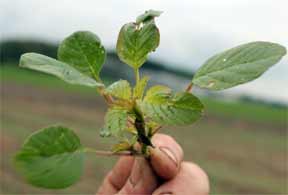
Glyphosate resistant palmer amaranth plants are up and growing in St. Joseph County.
Temperatures
A quick look around the region shows that we are at 587 GDD’s Base 50 since May 1. The average GDD accumulation Base 50 in the region for the next 10 days is 17.8 per day. The 6-to-10 and 8-to-14 day outlooks have southwest Michigan in the normal temperature range, with cooler than normal temperatures expected in the nearby forecast for much of Michigan.
Rainfall
Rainfall amounts around southwest Michigan since June 1 range from 0.66 inches in Lawton to 1.56 inches in South Haven. The average is 1.1 inches across the 12 MSU Enviro-Weather stations in the region. The 6 to 10 day outlook has southwest Michigan in the above normal range and 8-to-14 day outlook has the region in the normal precipitation range.
Crops
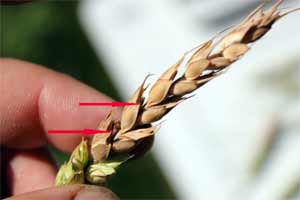 Wheat is moving into early grain fill. Most fields continue to look good. There is some incidence of Fusarium head blight on untreated fields. Bothincidence and severity appear to be low, with less than 3 to 5 percent of heads showing infection, and of these, only a few kernels infected. The pictures on the left and above are on a severely impacted head. Most treated fields show very low incidence. Armyworm has not been a factor in fields I have walked in St. Joseph and Van Buren counties. There is higher incidence of armyworm in corn in Calhoun County, so growers to the east should remain aware that the pest can be sporadically found in fields and could cause head clipping. Read MSU’s Chris DiFonzo’s article, Scout now for armyworm and cutworm in southern and central Michigan, for more on armyworms.
Wheat is moving into early grain fill. Most fields continue to look good. There is some incidence of Fusarium head blight on untreated fields. Bothincidence and severity appear to be low, with less than 3 to 5 percent of heads showing infection, and of these, only a few kernels infected. The pictures on the left and above are on a severely impacted head. Most treated fields show very low incidence. Armyworm has not been a factor in fields I have walked in St. Joseph and Van Buren counties. There is higher incidence of armyworm in corn in Calhoun County, so growers to the east should remain aware that the pest can be sporadically found in fields and could cause head clipping. Read MSU’s Chris DiFonzo’s article, Scout now for armyworm and cutworm in southern and central Michigan, for more on armyworms.
Alfalfa. Regrowth on early harvested first cutting is 6 to 8 inches tall. Later harvested fields are 2 to 4 inches tall. Continue to monitor fields for alfalfa weevil larvae and potato leaf hoppers. Also, it is important to be on the lookout for weed species that can impact hay quality. A common weed species that causes problems in hay quality in the southwest region is hoary alyssum. This weed can often be found on sandy soils. It has a white flower with small, flat, elongated seeds coming off of the main stem. Most of the plants I have seen do not have seeds yet. This weed species often causes toxicity challenges for horses. Read Identification, Livestock Toxicity and Control of Hoary Alyssum in Christmas Tree Plantations and Forages for more information on hoary alyssum and for control options in hay fields.
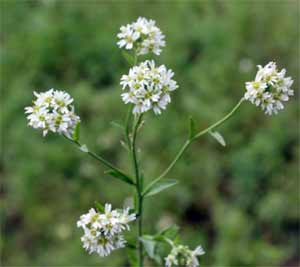
Hoary alyssum in flower near a Van Buren County alfalfa field.
Corn continues to be variable in both size and yield potential. Some fields around the region were pretty beat up by heavy rainfall following planting and are looking pretty rough. Early planted corn on mainly sands continues to look the best. Weed control from early plantings looks pretty good. Later planted fields have weed control issues that producers are scrambling to fix. Continue to watch for cutworm and armyworm damage in fields, particularly in Calhoun and Branch Counties. Read DiFonzo’s article on cutworm control in corn. Sidedress nitrogen applications are in full swing across the region. PSNT tests might be valuable for growers that applied nitrogen early in the season and planted later. Read MSU’s George Silva’s article on Initial PSNT results demonstrate nitrogen credit for corn.
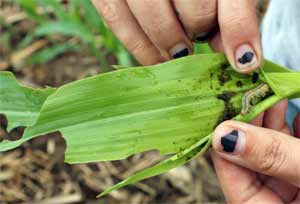
Armyworm in the whorl in a Calhoun County corn field. This one is large, but many are smaller.
A lot of magnesium deficiency type symptoms in fields this year, particularly on sandy soils low in organic matter. Read MSU’s Emily Sneller’s article on Magnesium deficiency issues in Michigan corn fields.
Seed corn is all over the board in terms of size. Some of May plantings were pounded by heavy rains, leaving some flood damage to fields that rarely see water ponding issues. A few fields in the prairie south of Constantine had stand reductions due to seedling diseases. MSU field crops pathologist Martin Chilvers is going to sample impacted plants from the area to hopefully determine the causal pathogen.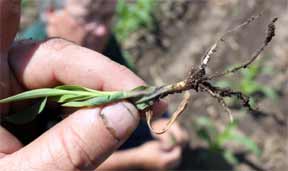
Early planted soybeans are V5-R1. Some beans are just emerging. No signs of soybean aphids as of yet. There continues to be a few seedling disease issues. Monitor fields for symptoms of soybean cyst nematodes and for early onset sudden death syndrome in areas prone to this disease over the next couple of weeks.
MSU pest management research projects in the region
Christy Sprague has established a pre- and post-emergence Glyphosate Resistant Palmer Amaranth Research Trial to evaluate the efficacy of various herbicide programs in controlling Palmer amaranth. The weed species was first found in St. Joseph County in Michigan in the summer of 2011. The weed is notoriously difficult to control in areas of the south, and the initial evaluations of the plot suggest that the same will be true in Michigan. Palmer amaranth is a member of the pigweed family, and can be distinguished from other weeds in that family by the long petioles on the leaves. The preemergence herbicide treatments have been initially evaluated. Post-emergence treatments will be going on soon. MSU Extension will be conducting transects throughout St. Joseph and Kalamazoo counties to look for incidence of this weed species. If you suspect that you have Palmer amaranth in your fields, contact MSU Extension weed control educator Dan Rajzer at 269-445-4438.
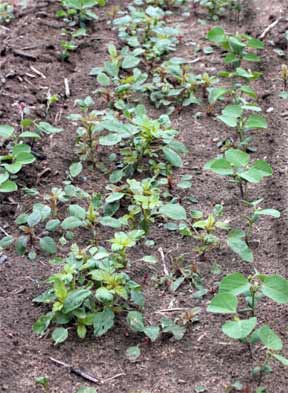
Palmer amaranth out-number soybean seedlings in untreated control plot in a trial in St. Joseph County.
Carl and Amy Druskovich of Decatur are cooperating with MSU researchers on a massive SDS/ White Mold Research Trial to look for varieties that are tolerant to sudden death syndrome (SDS). The site hosts a MSU Soybean Breeding Germplasm screening trial, a MSU Soybean Performance Variety Trial and other variety and seed treatment evaluations to evaluate option for managing for sudden death syndrome at this highly infected site. This research is being funded by the Michigan Soybean Promotion Committee (MSPC) and individual grants from the seed and crop protection industries. The MSPC is tentatively planning to sponsor an upscale field day event at this site on August 3.
Wheat variety trial tour will be held on Thursday, June 23 from 5:30 PM to 7:30 PM. The site is located at 3101 128th Avenue, Allegan. There is no registration fee for the tour. However, preregistration is requested as we plan to serve a light supper following the field day meeting. Janet Lewis from the MSU wheat breeding program will be the keynote speaker. We will also discuss wheat diseases and other field crop pest challenges. One RUP credit will be available. Please call the Allegan County MSU Extension office at 269-673-0370 by 5:00 PM, June 22 to preregister so we can plan for the meal.
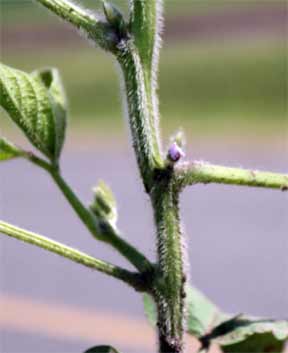
West Central Michigan – Fred Springborn, Michigan State University Extension
|
After 14 mostly dry days, the Montcalm area received 0.5 to nearly 2 inches of rain last night (June 15). Many well-drained soils were getting quite dry. High temperatures have been in the 60s to low 80s. Low soil temperatures are in the mid- to upper 60s. Even with the cool temperatures and fairly low humidity levels (often near 60 percent), evaporation and evapotranspiration rates have been fairly high.
Corn growth stage ranges from spike to V8. Condition of the crop ranges from excellent to fair at best. Until last night, some fields in Montcalm had wilted – drought-stressed plants at the tops of sandy hills and mud at the foot of the hill. Continue to scout fields for armyworm and black cutworm this week. Black cutworm outbreaks have been scattered. Read MSU’s Chris DiFonzo’s article, Q&A about the strange world of cutworms this season, for more on black cutworms.
Alfalfa harvest continues with many producers finished with first cutting. Alfalfa weevil larvae are present. Scout regrowth for this pest and potato leafhoppers.
Wheat is past flowering. As with corn, continue to scout fields this week for armyworms. See DiFonzo’s article, Scout now for armyworm and cutworm in southern and central Michigan, for more on scouting for armyworms.
Soybean planting is wrapping up. Several fields are emerged. Stands are generally good on later planted beans. Bean leaf beetle damage has been observed.
Drybean and pickle planting is underway. A few fields are emerging.
Central Michigan – Paul Gross, Michigan State University Extension
|
Weather
A week of dry weather has allowed farmers in the central region to wrap up planting of corn and soybeans. Rain on June 16 will be just what is needed to get the late planted crop up and growing. Most have reported poor planting conditions and the focus now will be on weed control and sidedress nitrogen applications.
Commodity reports
The corn crop is planted with the exception of fields that farmers opted for prevented planting. The crop is emerging quickly with the warm soils and adequate moisture. We are still getting reports of cutworm and armyworm in fields across the region. Farmers are encouraged to scout fields closely for insect problems (for more on armyworms and cutworms, read MSU’s Chris DiFonzo’s article, Scout now for armyworm and cutworm in southern and central Michigan). The early planted corn is doing very well and nearly knee high with very good stands. There are several reports of yellow stripping and other nutrient deficiencies.
The last of the soybeans are being planted this week. The early planted beans have their second trifoliate and are doing very well. Many fields are full of weeds and control is needed as they are competing for nutrients and there can be yield loss from this competition. Scout fields for insect and disease problems.
First cutting alfalfa harvest is nearly complete. Farmers are reporting excellent yields and good quality. Alfalfa weevil and potato leafhoppers have been found in several fields. Scout the regrowth for these pests. The dry weather of the last week has been very good for getting hay dry enough to bale.
The wheat crop is done flowering and is in the grain fill period. There is some lodging with rain and wind. The yield potential still looks very good.
Oats and barley are doing very well. Most are in need of herbicide applications. The new alfalfa seedings with the oats are doing very well.
Drybean planting is well under way. Early planted fields have emerged with very good stands. Planting will continue as conditions allow.
Sugarbeets have been sort of a challenge this spring with several farmers replanting. At this time things are settling down and the crop is making progress.



 Print
Print Email
Email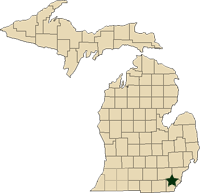
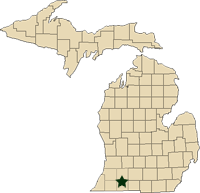 Southwest Michigan
Southwest Michigan